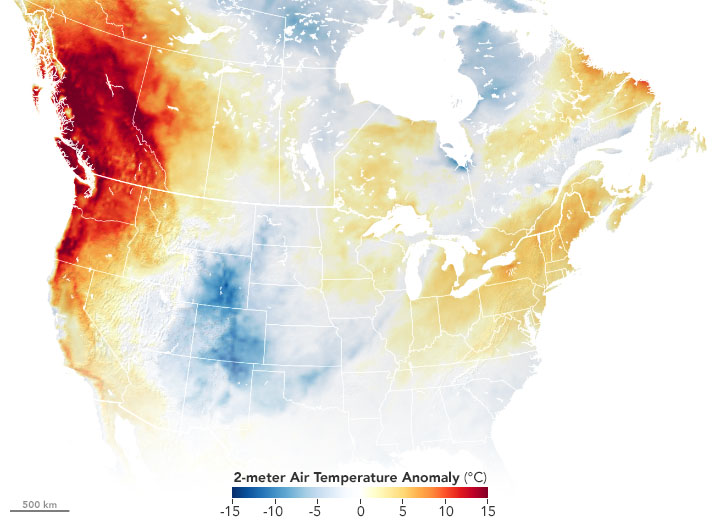 June 2021 US Temperatures, Photo Credit: NASA Earth Observatory/Joshua Stevens
June 2021 US Temperatures, Photo Credit: NASA Earth Observatory/Joshua Stevens
The Cost Behind Increasing Heat Domes
Heat domes pose an increasing threat to health and represent a rising risk for human and economic security in the United States. Heat domes form when temperatures vary in a specific region, causing a temperature gradient that forces pressure to gravitate towards the hotter area. This subsequently results in a shift in wind that traps the hot air below, leading to a heat wave in that specific area.
A Trend Towards Heat
According to a 2021 Intergovernmental Panel of Climate Change (IPCC) Report, it is very likely that extreme increases in temperature leading to more heat waves have occurred on a regional level in North America, Europe, Asia, and Australia since 1950. Since January of this year, the United States has already experienced several dangerous heat waves, severely impacting the health and safety of communities across the country. The Pacific Northwest region was hit particularly hard, enduring two heat domes between June and August alone.
In June, an intense heat dome settled upon parts of Washington State, Oregon, California, and Canada’s British Columbia, with Portland reaching 112 degrees Fahrenheit and Seattle reporting a 104 degrees temperature. Across the region, temperatures hit an average of 30 degrees Fahrenheit above normal. Similar record-setting events took place in August, as Portland hit 102 degrees Fahrenheit and Seattle hit 93 degrees, respectively. With temperatures 10-20 degrees above the average, communities were significantly impacted, leading Oregon Governor, Kate Brown, to declare a state of emergency.
Heat Domes’ Impact on Health
Apart from being abnormal temperatures for the region, these heat waves made headlines due to the dangerous effects excess heat has on human health. The body can withstand the heat to a certain point, but beyond that an individual may experience heat exhaustion, or in more extreme cases, heat stroke. Both heat exhaustion and stroke can lead to serious illness or death if left untreated. This is especially dangerous when individuals who experience symptoms cannot relieve themselves due to consistent hot temperatures and lack of resources.
As a direct result of excess heat in the Pacific Northwest from the June heat dome, over 200 people in the United States and 400 people in Canada died. An additional 600 individuals in the US died from illnesses correlated with the heat dome. Further, over 1,300 were hospitalized in Washington State alone.
Accompanying a rapid increase in temperature is an uptick in the number of individuals experiencing symptoms of heat exhaustion or stroke. When this sudden and rapid increase in symptoms occurs, hospitals and other medical facilities become overburdened and patient wait times increase, perpetuating the problem as more and more individuals experience worsening symptoms and facilities cannot treat every person in a timely manner. In the Pacific Northwest, average emergency response times doubled, and many emergency responders and 911 operators were overwhelmed with people seeking medical assistance.
The Economic Cost behind Heat Domes
The June heat dome also took a grave toll on the agricultural industry. After working through the heat to move irrigation lines, a farm worker in Oregon died from heat stroke. His sudden death sparked Washington and Oregon governments to issue emergency policies requiring companies to provide shaded areas and cool down resources, as well as regular paid rests. The lack of protections for workers not only endangers human health, but also the economic security agriculture provides to the region. Without protections, heat domes affect the safe and efficient management of farmlands — lowering production and threatening the multi-billion dollar benefit farming brings to the Pacific Northwest. Extreme heat also exacerbates drought conditions and wildfires, further threatening the industry. During the heat wave, excess heat strengthening a nearby wildfire destroyed 115 acres of a pear tree farm, costing the company over $350,000. The potential for more frequent heat waves places agricultural workers and the industry at risk.
Moving Forward
The adverse effects excess heat has on the human body, and its mounting stress on the emergency response system and agricultural industry, calls into question what can be done to address the problem. While heat domes caused record-highs for the region, their increasing frequency suggests there will be more heat waves in the future, and the main culprit of this trend is climate change. Addressing climate change and lowering the earth’s temperatures will take the collaboration of many actors and corporations, and it will take time. The next post in this series will examine the current capacity to reverse rising temperatures and need for mitigation and resilience strategies, such as preparing emergency response systems and the agricultural industry for excess heat. By working with both mitigation and prevention strategies, the human and economic costs of heat domes can be minimized.





